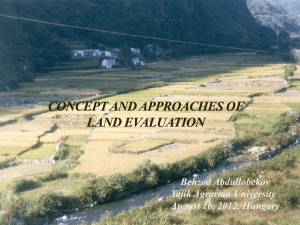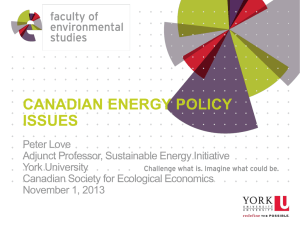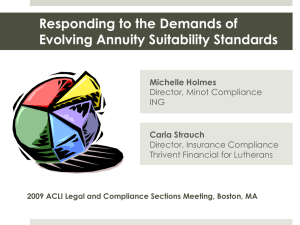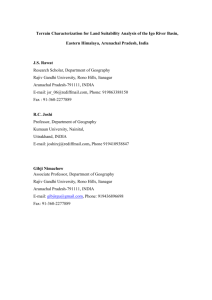Prioritization of sub-watersheds for the application of environmental
advertisement
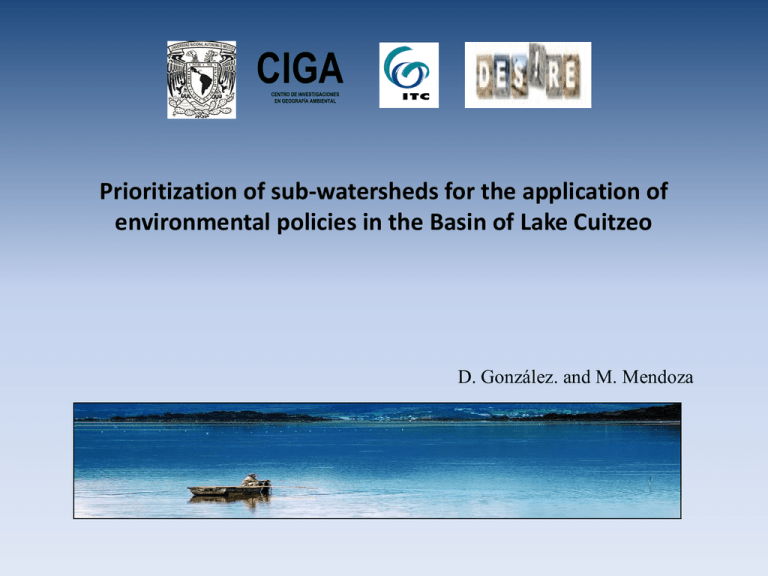
CIGA CENTRO DE INVESTIGACIONES EN GEOGRAFÍA AMBIENTAL Prioritization of sub-watersheds for the application of environmental policies in the Basin of Lake Cuitzeo D. González. and M. Mendoza Background Lake Cuitzeo Basin is an important ecologic area, where is a strong pressure on the natural resources by the productive activities. Its necessary the implementation of the environmental programs to keep the equilibrium among the productive activities and natural resources. (conservation and sustainable use territorial policies) It becomes necessary to identify and recommend to the authorities which are the priorities areas to apply the environmental programs Objective Identify the priority water-sheds for the implementation of selected environmental policies to support sustainable development in the Lake Cuitzeo Basin Study site Spot image 321, Dec 2006 •Center of Mexico •Michoacan state •4,000 Km.2 •Transmexican Volcanic Belt •Lake Cuitzeo (Ecological importance) •55 watersheds •28 Municipalities •Urban expansion •High migration rates Method Problem formulation Formulation Objective of environmental policies Assessment ofofthe municipalities Assessment sub-watersheds Construction of the criteria tree structure in the SMCE module in ILWIS 3.3. Ranking of sub-watersheds Ranking of the municipalities Definition of new criteria structure for each policy for the choice phase Literature review Definition of ideal areas for the application of conservation and sustainable use policies Definition of relevant criteria Definition of constraints Partial Valuation Construction of the indicators to asses the subobjectives SMCE Establish the relative importance of criteria Partial Valuation Establish the relative importance of criteria (Pairwise comparison) Aggregationininthe subAggregation watersheds municipalities Composite suitability index map for each policy Rank order of the municipalities for each policy Assessment of Evaluation of municipalities sub-watersheds for each policy Evaluate the overall Results SMCE Concerned policies According to the local environmental law, the main objective for the application of the environmental policies are: Conservation To preserve the environmental elements that allow maintain the environmental services To minimize the conflicts between the productivity activities and the conservation programs Sustainable use Define the areas where the productive programs can be developed according to the distribution of the land capability To minimize the deterioration of areas containing a well preserved natural capital Find criteria to asses the objectives 1. Find criteria, it should be: Relevance • be related to the assessment goal • be sensitive and responsive to change in the system. Analytic • be theoretically founded, Measurable • be easy to detect, record, and interpret • be cost effective • be precisely-defined 2. Standardization. • Maximum • Interval • Goal • Pairwise comparition • Rank order Continous variables Discrete variables Criteria structure for assessing the suitability for conservation policy Criteria structure for assessing the suitability for the sustainable use policy Example. Suitability assessment of the municipalities Forest stability Stable productive areas Results Overall suitability assessment of the subwatersheds for the conservation policy (A) and sustainable use (B) Ranking of sub watersheds Selected criteria for the assessment of the sub-watersheds Supply -Connectedness of suitability classes -Percentage of cover of the best performance cells per spatial unit. • Demand - Relative poverty index Decree - Percentage of area assigned for conservation and sustainable use by the EMPLCB • The overall suitability index were assesed through 3 scenarios -Supply, Demand, Decree • Decision rules were implemented to construct an integrative suitability map map. Relative importance of criteria in each scenario Decision rules to classify the integrative suitability map Potential conflicts in sub watersheds • Potential conflicts among the implementation of the environmental policies are identified based on the comparison of the suitability indexes for each subwatershed Map of potential conflicts among environmental policies by sub-watershed Total area in percentage by conflict area. Comparison between natural and administrative spatial units Sub-watersheds Municipalites No conflict 1st order Mixed 2nd order No conflict 2ndorder Mixed 3th order Conclusions • The multi-temporal analysis through a long and a short term of time allows identifying the trends of the land use change for support the implementation of the environmental policies. • Three different orientations of the municipalities were identified: 1) Oriented to productive activities, 2) Oriented to conservation activities and 3) Mixed oriented • The prioritization of the sub-watersheds could be a practical information that can be used as support to planning the implementation and the monitoring of the environmental programs in the framework of the EMPLCB • Intermunicipal efforts have to be implemented in the framework of Integrated Watershed Management. Gracias. Ranking of sub-watersheds Conservation policy Compensatory approach. Weighted summation Ranking of municipalities Sustainable use policy Compensatory approach. Weighted summation Suitability assessment of the municipalities Relative importance among criteria. Conservation policy Suitability assessment of the municipalities Relative importance among criteria. Sustainable use policy






